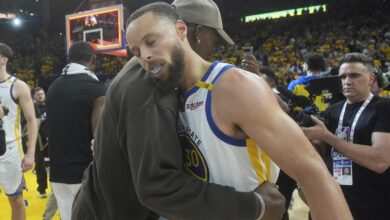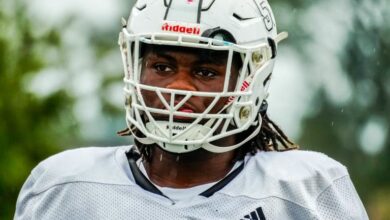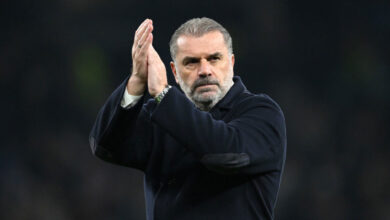Best power forwards in history
Whenever discussing the greatest power forwards of all time, the name Tim Duncan inevitably comes up. The problem with saying the Big Fundamental is the greatest power in NBA history is that Duncan wasn’t a power forward!
He played center for the majority of his career. Yes, when he played second banana to David Robinson, Timmy played PF.
However, after Robinson’s retirement, he was the San Antonio Spurs center. According to Basketball Reference, it wasn’t particularly close either — Tim Duncan played 63% of his career at center and 36% at power forward. So if it’s not Tim Duncan, who is actually top of the greatest power forwards of all time?
Greatest power forwards of all time
Like every position in the NBA, the PF role has blurred as the league progresses. Many players stretch it out beyond the three-point line. Some will play the perimeter on offense, in the paint on defense, and vice versa. Others have perfected the point-forward role and don’t just grab the rebound but bring the ball up as well. A versatile power forward has gone from a luxury to a necessity. With that said, who is the best forward in NBA history?
15) Shawn Kemp
If you’re not sure Shawn Kemp was one of the best PFs ever, know this: In the NBA Finals against one of the greatest teams in NBA history, the 1995-96 Chicago Bulls, the Bulls could not guard him. Kemp scored 23.3 points per game while making 55% of his shots. He annihilated Chicago in the paint on both ends, averaging two blocks and being sent to the line for eight free throw attempts per game.
In a league filled to the brim with explosive athletes, the Reign Man may have been the fiercest of them all.
Whenever Gary Payton threw a basketball to the sky, Kemp came down with it. He could power through a crowd of defenders and dunk on everybody. Unfortunately, off-court issues and injuries cut his career short, but for a short period in the ’90s, Kemp had a strong argument for the best PF in the league.
14) Dennis Rodman
For decades rebounding was considered an effort play, but Dennis Rodman made it a science. The Worm dissected his opponent’s shots to know where the ball would come off the rim. In a land of giants, Rodman would soar above them all.
At just 6’6″, Rodman led the league in rebounding for seven consecutive seasons in the 90s. Teams could not box out Rodman. He owned the boards. Dennis Rodman retired eleventh all-time in rebounds per game and is by far the smallest player in the top 50.
13) Draymond Green
Draymond Green‘s greatness as a player is wrapped up in intangibles that are difficult to measure. He rarely jumps off the stat sheet. But, he quarterbacked a Golden State Warriors defense that was consistently elite.
Green’s versatility as a passer and ball handler allowed Klay Thompson and Stephen Curry to wreak havoc off-ball and confuse defenses.
Draymond Green‘s fire has sparked controversy, but it’s mostly been positive, helping ignite a Warriors team that’s won four titles and competed for six during his time in the Bay. Don’t let the box scores fool you — Green is one of the greatest power forwards of all time.
12) Anthony Davis
Physically, you couldn’t ask for a better power forward. At 6’10” and 250 pounds, Anthony Davis can move seamlessly between PF and C. The Brow has a complete toolbox on offense that allows him to attack back to the basket or face up.
On defense, AD’s athleticism allows him to roam the entire court. He’s a menace in the paint that isn’t a liability when switched out onto guards—the perfect prototype for today’s NBA.
Unfortunately, injuries have kept Davis off the court for much of his career. His first seven years playing for the New Orleans Pelicans left much to be desired. Despite his physical dominance and ability to fill the stat sheet, AD couldn’t consistently lead the Pelicans to a winning record as the lead dog.
11) Dave DeBusschere
Watching old Dave DeBusschere footage is wild. There’s no three-point line, but Dave is stretched way out to the corner, sinking daggers and creating space for his teammates.
Beyond being one of the first big guys to understand the benefits of long-range shooting, he was a relentless defender. The NBA didn’t create All-Defense teams until halfway through his career – once they did, he made it every season until he retired.
In DeBusschere, you have a player who didn’t just dominate the 60s and 70s but would’ve excelled playing in the wide-open game of today.
10) Jerry Lucas
Jerry Lucas and Dave DeBusschere feel like two sides of the same coin. They’re both well-known New York Knick power forwards that played from the 60s through mid-70s and would’ve benefited greatly from a three-point line. They even look the same. Lucas was a little more clean-cut, but if you close your eyes and picture a white basketball player from the 70s, they’re the image you conjured.
The skill that separates them is rebounding. Lucas was one of the best rebounders of all time. Like Rodman before Rodman — Lucas would sell out to rack up huge rebounding numbers during his time. Jerry Lucas grabbed over 16 boards per game for six straight seasons, including two seasons eclipsing the 20 rebound mark.
9) Elvin Hayes
Not just one of the greatest power forwards of all time, Elvin Hayes was an all-time iron man. The Big E played 80+ regular season games every season of his illustrious 16-year career. He’s 13th in total points, 6th in total rebounds, and 7th in minutes played.
Hayes also popularized the unguardable fadeaway jumper Dirk Nowitzki and Kevin Garnett would later perfect. Elvin Hayes is also known as one of the first chokers, often disappearing in the fourth quarter and winning his only title with the Washington Bullets after he fouled out.
8) Chris Webber
There aren’t many players who could go toe to toe with the Kobe and Shaq Lakers and be the best player on the court. But, more than a few times, Chris Webber did.
The electric power forward wasn’t just a monster scorer and menace on the boards. C-Webb was a slick passer who excelled in one of the NBA’s first uptempo offenses. Webber’s Sacramento Kings teams have a strong claim at the 2002 NBA title as well, as it’s widely believed they were robbed by the refs.
He doesn’t have the longevity of his contemporaries, but before his career was cut short by injuries, Chris Webber was one of the best power forwards in NBA history.
7) Bob Pettit
The first great NBA player, Bob Pettit, is also one of the hardest players to rank. He’s undoubtedly one of the best power forwards of all time, but is it only cause of the era Big Blue played?
Pettit started his career in the mid-50s before many teams allowed black players. But he also won his only title against Bill Russell‘s Boston Celtics, so he wasn’t playing nobodies his entire career either. Pettit’s offensive game was just layups and mid-range push shots, yet he’s one of the greatest scorers of all time and a two-time scoring champ. He also ground out 16 rebounds per game for his career.
Bob Pettit was the definition of a lunch pail player — a white guy with average athleticism who spent his entire career piling up incredible stats while not doing anything that made anybody say ‘wow.’
6) Kevin McHale
Kevin McHale had the most beautiful post-game this side of Hakeem Olajuwon. McHale’s touch around the basket was unparalleled, and his bag of moves was bottomless. He led the league in field goal percentage twice and averaged 55% for his career.
The man was unguardable as any player in NBA history. Kevin McHale wasn’t a slouch on defense either — the same swift movements McHale used on offense allowed him to excel on defense. Nimble and quick in tight spaces, being stuck one-on-one with McHale was hell on both sides of the court.
5) Karl Malone
Even though Karl Malone retired second all-time in points, his career still feels like a disappointment. Maybe it’s his unsavory personal life, Scottie Pippen‘s “the Mailman doesn’t deliver on Sunday.” quip, or the fact he retired without a ring. The Mailman didn’t elevate his team like the other greatest power forwards of all time did. The two Finals Karl Malone played in saw the Utah Jazz get wiped off the face of the earth by the Chicago Bulls.
Malone and John Stockton racked up more counting stats than anybody in league history. They also shrunk in the playoffs more than any other duo in NBA history. If you want to make the playoffs, call up Stockton and Malone. If you want to win while you’re there, call somebody else.
4) Kevin Garnett
“Anything is possible!” Kevin Garnett was forever immortalized from the moment he yelled those words. After years of wasting away on terrible Minnesota Timberwolves teams, Garnett was finally called from exile by the Boston Celtics and became a world champion.
Outside of a three-pointer, KG was everything you could ask for in a modern power forward. Positional versatility, inside-outside scoring, and the ability to defend across five positions. The Big Ticket won’t just be remembered as one of the best PFs of all time but as one of the league’s greatest competitors too.
3) Charles Barkley
The Round Mound of Rebound revolutionized the point-forward position. Today, Charles Barkley is known for the gift of gab, but in the 80s and 90s, he was an unstoppable force on the court. Sir Charles’ strength and explosive athleticism made him a handful for defenses. Charles Barkley could back down defenders who towered over him and slowly work his way to the basket or blow by guards with lightning-quick acceleration.
Barkley’s game spanned the entire length of the court too. Like LeBron, Chuck could run a fast break as well as anyone and take it to the cup himself or dish out slick passes to set up teammates. The best player to never win an NBA title and one of the greatest power forwards of all time.
2) Dirk Nowitzki
This isn’t too high for Dirk Nowitzki. The term cheat code was made for Dirk. He wasn’t the two-way dynamo others on this list were, but he was an offense unto himself. The Dallas Mavericks went to the playoffs every year of Dirk’s prime with some pretty average rosters. Even the title-winning team that toppled the Heatles didn’t have a single great player outside of Nowitzki.
The Mavericks won 60 games three times during Dirk’s tenure, all due to his unstoppable one-legged fadeaway jumper. There was no defense for Dirk; even the great Tim Duncan struggled to guard him. Bucket after bucket, Dirk Nowitzki was automatic, and there’s almost no better power forward in the history of the NBA for tilting the court in your favor.
1) Giannis Antetokounmpo
His career isn’t close to being over, and Giannis Antetokounmpo has already put together a resume as strong as anyone’s on this list. At just 27 years old, Giannis is a two-time league MVP, Defensive Player of the Year, NBA champion, and Finals MVP. He has perfected the prototype we’ve mentioned throughout the article. If you put Giannis in the paint, he’s Shaq-like in his ability to power through defenders. The Greek Freak can handle the ball like a guard and make passes all over the court.
But it’s defense where Giannis really shines. From the perimeter to the paint, Giannis is here to ruin your day.
His ability to come out of nowhere and send someone shot into orbit is jaw-dropping. There is arguably no better player in the NBA today, and by the time Giannis retires, he will undoubtedly be the greatest power forward of all time.
How much do power forwards make?
Power forwards are invariably among the highest earners in the NBA. Giannis Antetokounmpo, Jayson Tatum, Kevin Durant, and Anthony Davis have received some of the largest annual salaries in league history.
Is Giannis a power forward?
Yes, Giannis Antetokounmpo is primarily a power forward. While the Greek Freak is capable of playing center and can run the offense, he mainly plays at the four next to a three-point shooting five. Giannis’ role can alter depending on who he is sharing the court with — he can guide one through five if required.
Do power forwards need to be fast?
In the modern game, power forwards need to be very mobile. Power forwards need to be able to guard on the perimeter and close out to three-point shooters while having the size and strength to compete with bigs in the paint and get their fair share of rebounds. It is vital that a starting power forward can run in transition and guard smaller players.
Has KD ever played power forward?
Yes, Kevin Durant has been a power forward for much of his career. Durant started out as a shooting guard, and will mainly be thought of as a small forward, but he has often been used at the four by the Golden State Warriors, Phoenix Suns, and Brooklyn Nets. The future Hall of Famer has even played the five on occasion.
Did Shaq ever play power forward?
No, Shaquille O’Neal was not a power forward. O’Neal was a true center.
Has LeBron ever played power forward?
LeBron James has played power forward for significant chunks of his career. James was a power forward with the Miami Heat and during his second stint with the Cleveland Cavaliers. He has played the one, three, four, and five as a Los Angeles Laker.
Can power forwards shoot threes?
Most active power forwards can shoot threes. Throughout NBA history, a lot of power forwards did not shoot threes, and instead focused on mid-range buckets or attacking the basket. In the 2020s, there are often spacing issues if a power forward doesn’t take shots from beyond the arc.
What is a good height for a power forward?
Power forwards are often between 6’8 and 6’10. Anyone at 6’5 or 6’6 would be undersized at the position, but some players at this height excel as a four. Sometimes there are players at 6’11 or 7’0 who end up playing power forward because their frame/skillset is not suited to playing center.
https://franchisesports.co.uk/wp-content/uploads/2022/09/USATSI_16429221.jpg
2024-09-15 06:20:15




